Birth Defects Surveillance System, 1990-1999
West Virginia Residents
The West Virginia Birth Defects Surveillance System (BDSS) was established
in 1989 to monitor the occurrence of birth defects among the state's children.
The BDSS is housed within the West Virginia Bureau for Public Health and
is administered jointly by the Office of Maternal, Child and Family Health
and the Office of Epidemiology and Health Promotion.
Using data from the BDSS registry, 5,161 state residents born from 1990
through 1999 were diagnosed with one or more birth defects. Based upon
the 214,497 births that occurred to West Virginia residents during that
same time period, a rate of 24.1 defects per 1,000 live births results.
However, when compared to national figures, the rate is low. In order
to produce a more accurate report of the prevalence of birth defects,
an effort was made to detect cases of birth defects from other sources.
Since the presence of congenital anomalies is noted on the birth certificate,
all birth certificate records that indicated a congenital anomaly not
already in the BDSS were added to the data set. In addition, any fetal
death* record that indicated a congenital anomaly was the underlying cause
of death was also added. With these additions, 8,096 West Virginia residents
were observed to have one or more birth defects, a rate of 37.7 per 1,000
live births.
| Table One |
Birth Defects Records by Source
West Virginia Residents, 1990-1999 |
| Year |
Birth
Defects
Registry |
Births
Not in
Registry |
Fetal
Deaths |
Total
Combined
Records |
| 1990 |
496 |
439 |
16 |
951 |
| 1991 |
526 |
266 |
4 |
796 |
| 1992 |
449 |
315 |
2 |
766 |
| 1993 |
490 |
285 |
0 |
775 |
| 1994 |
519 |
283 |
1 |
803 |
| 1995 |
566 |
330 |
4 |
900 |
| 1996 |
562 |
278 |
5 |
845 |
| 1997 |
682 |
270 |
4 |
956 |
| 1998 |
471 |
229 |
3 |
703 |
| 1999 |
400 |
199 |
2 |
601 |
| Total |
5,161 |
2,894 |
41 |
8,096 |
* Death of a fetus with a gestational age of at least 20 weeks.
Demographic Factors
A demographic factor that influences the rate of birth defects is maternal
age. Women 35 years and older have higher rates of children with birth
defects than those of younger ages, 42.2 defects per 1,000 live births,
as compared to 37.7 for women of all ages.

The weight of infants at the time of birth is an important factor affecting
the rate of birth defects. In infants that weighed less than 1,500 grams
(three pounds, five ounces) a rate of 211.6 per 1,000 live births was
observed. Babies between 1,500 and 2,499 grams (five pounds, eight ounces)
had defects at a rate of 81.2. Of infants who weighed 2,500 grams or more,
only 31.8 per 1,000 live births had defects.
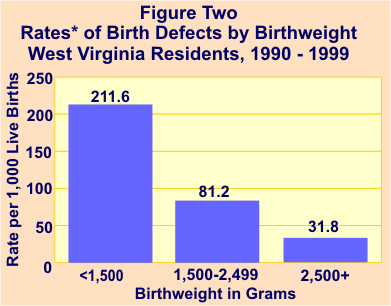
There is a marked difference in the rates of birth defects between premature
births and infants who are born after a normal gestational period. Children
with a gestational age of less than 37 weeks were diagnosed with one or
more congenital anomalies at a rate of 92.1 per 1,000 live births. However,
those with a gestational age of 37 weeks or more were diagnosed at a rate
of 31.9 per 1,000 live births.
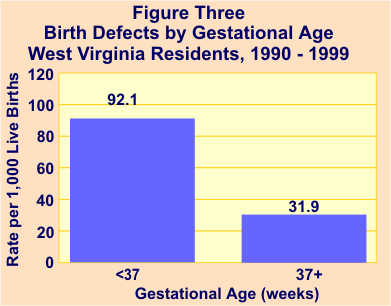
There is a measurable difference between the observed
rates of birth defects among white mothers and mothers of other races.
Children of mothers of other races had a reported rate of birth defects
of 48.1 per 1,000 live births, while children of white mothers were observed
to have birth defects at a rate of 37.3 per 1,000 live births.
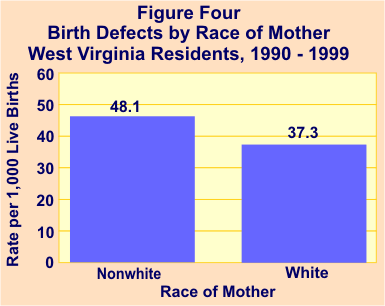
Multiple births is another factor that tends to increase the rate of
birth defects. Singleton births produce a rate of 36.8 birth defects per
1,000 live births. In contrast, twins, triplets, and quadruplets collectively
have birth defects at a rate of 63.4, nearly twice that of singleton births.
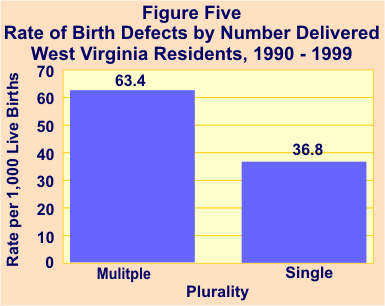
The timeliness of prenatal care affects the rate of birth defects. Those
women who received no prenatal care produced children with defects at
a rate of 58.3 per 1,000 live births. In contrast, those who began prenatal
care in the first trimester of pregnancy gave birth to children with defects
at a rate of 36.7 and those who started prenatal care during the second
trimester produced children with defects at a rate of 36.2. Those who
waited until the third trimester had a birth defect rate of 41.0.
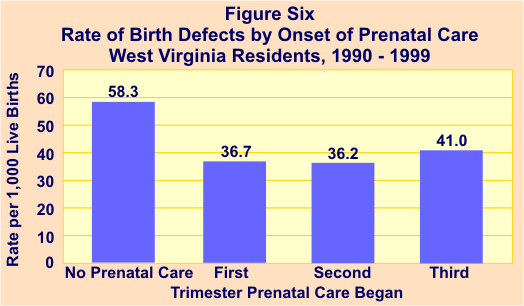
As with timeliness, the quantity of prenatal care affects the rate of
birth defects. Those women who visited their obstetricians fewer than
10 times before giving birth produced children with defects at a rate
of 41.7 per 1,000 live births. Those who had 10 to 19 prenatal visits
gave birth to children with defects at a rate of 34.7. However, those
who had 20 or more prenatal visits, most likely those known to have pregnancy
complications, produced children with defects at a much higher rate, 53.6
per 1,000 live births.
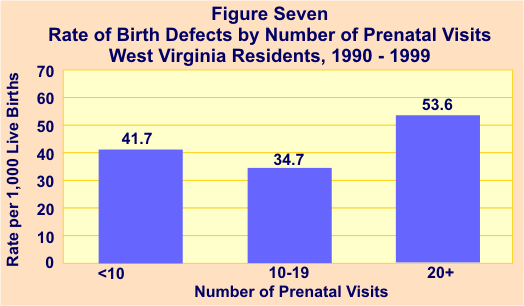
The prevalence of birth defects declines as the education level of mothers
increases. Mothers with less than 12 years of education gave birth to
children with defects at a rate of 39.3 per 1,000 live births. Those with
12 years of education produced children with defects at a rate of 37.2.
Mothers who had 13 or more years of education gave birth to children with
defects at an even smaller rate, 34.1 per 1,000 live births.
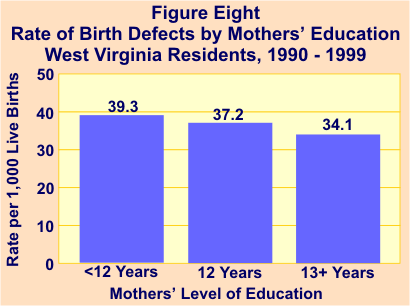
Women who consume alcohol greatly increase the risk of giving birth
to children with defects. Children of women who did not consume alcohol
had a reported rate of 37.2 birth defects per 1,000 live births. However,
women who drank alcoholic beverages during pregnancy gave birth to children
with birth defects at an observed rate of 71.6.
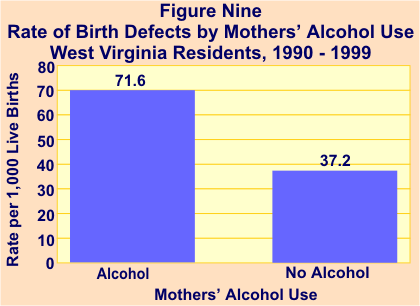
Children of mothers who smoked during pregnancy have a higher risk of
birth defects than those whose mothers did not smoke. Mothers who smoked
gave birth to children with birth defects at a rate of 41.6 per 1,000
live births, as compared to a rate of 36.4 among children of mothers who
did not smoke during pregnancy.
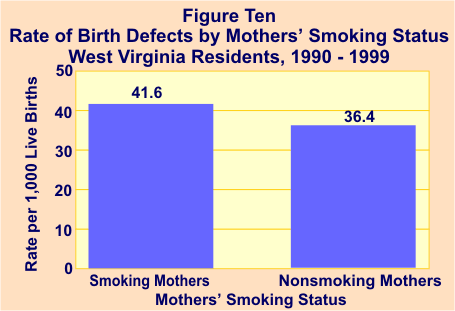
The rate of birth defects by county of residence varies widely (see Table
Two). Fayette County had the highest observed rate, 62.0 per 1,000 live
births, followed by Raleigh County (56.2) and Berkeley County (54.3).
The lowest observed rates were in Mercer County (20.9), Logan County (23.5),
and Kanawha County (24.6).
Table Two
Birth Defects by County of Residence
West Virginia Residents, 1990 - 1999 |
County of
Residence |
Births With
Defects |
Rate per 1,000
Live Births |
County
Rank |
County of
Residence |
Births With
Defects |
Rate per 1,000
Live Births |
County
Rank |
| Barbour |
86 |
48.1 |
7 |
Monongalia |
414 |
47.4 |
10 |
| Berkeley |
500 |
54.3 |
3 |
Monroe |
38 |
27.5 |
48 |
| Boone |
100 |
30.7 |
39 |
Morgan |
66 |
45.1 |
14 |
| Braxton |
60 |
38.7 |
25 |
Nicholas |
103 |
34.5 |
34 |
| Brooke |
101 |
38.3 |
26 |
Ohio |
286 |
50.4 |
5 |
| Cabell |
457 |
38.7 |
24 |
Pendleton |
30 |
33.2 |
36 |
| Calhoun |
35 |
42.7 |
18 |
Pleasants |
26 |
29.9 |
43 |
| Clay |
38 |
28.8 |
45 |
Pocahontas |
33 |
32.9 |
37 |
| Doddridge |
33 |
40.2 |
21 |
Preston |
154 |
45.5 |
12 |
| Fayette |
358 |
62.0 |
1 |
Putnam |
161 |
28.1 |
47 |
| Gilmer |
33 |
44.9 |
15 |
Raleigh |
495 |
56.2 |
2 |
| Grant |
59 |
42.9 |
17 |
Randolph |
153 |
46.6 |
11 |
| Greenbrier |
145 |
36.8 |
31 |
Ritchie |
39 |
35.5 |
33 |
| Hampshire |
88 |
38.1 |
28 |
Roane |
48 |
28.4 |
46 |
| Hancock |
95 |
27.3 |
50 |
Summers |
53 |
43.3 |
16 |
| Hardy |
45 |
31.4 |
38 |
Taylor |
88 |
53.3 |
4 |
| Harrison |
328 |
38.1 |
27 |
Tucker |
40 |
49.5 |
6 |
| Jackson |
81 |
25.9 |
52 |
Tyler |
31 |
30.0 |
41 |
| Jefferson |
208 |
40.9 |
20 |
Upshur |
108 |
40.2 |
22 |
| Kanawha |
622 |
24.6 |
53 |
Wayne |
202 |
39.8 |
23 |
| Lewis |
75 |
37.7 |
30 |
Webster |
31 |
27.3 |
49 |
| Lincoln |
77 |
27.2 |
51 |
Wetzel |
94 |
41.1 |
19 |
| Logan |
118 |
23.5 |
54 |
Wirt |
19 |
29.9 |
44 |
| McDowell |
118 |
30.0 |
42 |
Wood |
396 |
36.8 |
32 |
| Marion |
245 |
37.9 |
29 |
Wyoming |
147 |
47.9 |
8 |
| Marshall |
190 |
47.6 |
9 |
 |
 |
 |
 |
| Mason |
97 |
33.3 |
35 |
 |
 |
 |
 |
| Mercer |
167 |
20.9 |
55 |
WV Total |
8,096 |
37.7 |
 |
| Mineral |
143 |
45.3 |
13 |
 |
 |
 |
 |
| Mingo |
135 |
30.3 |
40 |
 |
 |
 |
 |
County of
Residence |
Births With
Defects |
Rate per 1,000
Live Births |
County
Rank |
County of
Residence |
Births With
Defects |
Rate per 1,000
Live Births |
County
Rank |
As with data by county, a wide variance is observed in the reporting
of birth defects by hospital of birth (see Table Three). Of hospitals
where at least 100 births occurred during the time period of 1990 - 99,
the highest observed rates of birth defects were recorded at West Virginia
University Hospital, with a rate 92.5 birth defects per 1,000 live births,
City Hospital (63.8), and Calhoun General Hospital (63.0). The lowest
rates were reported at New River Birthing Center (4.5), Putnam General
Hospital (10.0), and Putnam Birthplace (11.8). The difference in rates
by hospital may be more a measurement of completeness of reporting than
the health of the babies delivered in the various facilities. In addition,
birthing centers and smaller hospitals refer high-risk pregnancies to
the state's three tertiary care hospitals, i.e., WVU Hospital, CAMC, and
Cabell-Huntington Hospital, a possible factor in WVU Hospital's high rate.
Other issues such as the quality of prenatal care available at the surveyed
facilities may also be factors in rate variation.
Table Three
Birth Defects by Hospital1 of Birth by Source of Report
West Virginia Residents, 1990-1999 |
| Hospital of Birth |
Birth Defects
Registry |
Vital
Statistics2 |
Combined
Birth Defects |
| Number |
Rate |
Number |
Rate |
Number |
Rate |
Rank |
| Bluefield Regional Medical Center |
89 |
17.6 |
28 |
5.5 |
117 |
23.1 |
30 |
| CAMC - Women & Children's |
729 |
19.9 |
160 |
4.4 |
889 |
24.3 |
29 |
| Cabell-Huntington Hospital |
586 |
35.7 |
93 |
5.7 |
679 |
41.3 |
8 |
| Calhoun General Hospital |
13 |
54.6 |
2 |
8.4 |
15 |
63.0 |
3 |
| Camden-Clark Memorial Hospital |
167 |
22.9 |
49 |
6.7 |
216 |
29.6 |
22 |
| City Hospital |
410 |
50.5 |
108 |
13.3 |
518 |
63.8 |
2 |
| Davis Memorial Hospital |
188 |
34.9 |
32 |
5.9 |
220 |
40.9 |
9 |
| Fairmont General Hospital |
136 |
21.9 |
23 |
3.7 |
159 |
25.7 |
26 |
| Grant Memorial Hospital |
65 |
20.7 |
38 |
12.1 |
103 |
32.8 |
15 |
| Greenbrier Valley Hospital |
89 |
18.5 |
72 |
14.9 |
161 |
33.4 |
13 |
| Jackson General Hospital |
11 |
9.4 |
12 |
10.3 |
23 |
19.7 |
33 |
| Jefferson Memorial Hospital |
20 |
10.0 |
46 |
23.0 |
66 |
33.0 |
14 |
| Logan General Hospital |
70 |
11.6 |
51 |
8.5 |
121 |
20.1 |
32 |
| Monongalia General Hospital |
91 |
20.8 |
17 |
3.9 |
108 |
24.7 |
27 |
| New River Birthing Center |
0 |
0.0 |
1 |
4.5 |
1 |
4.5 |
37 |
| Ohio Valley Medical Center |
63 |
24.7 |
31 |
12.2 |
94 |
36.8 |
10 |
| Pleasant Valley Hospital |
25 |
22.3 |
14 |
12.5 |
39 |
34.7 |
11 |
| Preston Memorial Hospital |
40 |
22.7 |
17 |
9.6 |
57 |
32.3 |
16 |
| Princeton Community Hospital |
27 |
5.1 |
62 |
11.7 |
89 |
16.8 |
34 |
| Putnam Birthplace |
2 |
7.9 |
1 |
3.9 |
3 |
11.8 |
35 |
| Putnam General Hospital |
1 |
10.0 |
0 |
0.0 |
1 |
10.0 |
36 |
| Raleigh General Hospital |
146 |
8.8 |
885 |
53.1 |
1,031 |
61.8 |
4 |
| Reynolds Memorial Hospital |
41 |
21.2 |
13 |
6.7 |
54 |
27.9 |
24 |
| Roane General Hospital |
13 |
8.9 |
23 |
15.8 |
36 |
24.7 |
28 |
| St. Joseph's Hospital (Wood) |
190 |
39.3 |
21 |
4.3 |
211 |
43.6 |
7 |
| St. Joseph's Hospital (Upshur) |
56 |
21.5 |
26 |
10.0 |
82 |
31.4 |
18 |
| St. Mary's Hospital |
37 |
9.0 |
53 |
12.8 |
90 |
21.8 |
31 |
| Stonewall Jackson Memorial Hospital |
67 |
26.4 |
14 |
5.5 |
81 |
31.9 |
17 |
| Summersville Memorial Hospital |
31 |
12.1 |
36 |
14.1 |
67 |
26.2 |
25 |
| Thomas Memorial Hospital |
162 |
36.3 |
35 |
7.9 |
197 |
44.2 |
6 |
| United Hospital Center - Downtown |
171 |
18.0 |
127 |
13.4 |
298 |
31.4 |
19 |
| Weirton Medical Center |
52 |
20.8 |
24 |
9.6 |
76 |
30.4 |
21 |
| Welch Emergency Hospital |
26 |
13.4 |
31 |
16.0 |
57 |
29.4 |
23 |
| West Virginia University Hospital |
728 |
69.6 |
240 |
22.9 |
968 |
92.5 |
1 |
| Wetzel County Hospital |
32 |
19.6 |
18 |
11.0 |
50 |
30.6 |
20 |
| Wheeling Hospital |
339 |
47.6 |
18 |
2.5 |
357 |
50.1 |
5 |
| Williamson Memorial Hospital |
23 |
16.1 |
26 |
18.2 |
49 |
34.3 |
12 |
| West Virginia Total |
5,161 |
24.1 |
2,935 |
13.7 |
8,096 |
37.7 |
 |
Hospital of Birth |
Number |
Rate |
Number |
Rate |
Number |
Rate |
Rank |
Birth Defects
Registry |
Vital
Statistics2 |
Combined
Birth Defects |
1. Only hospitals with at least 100 births from 1990
through 1999 are included.
2. Birth records indicating a congenital anomaly not in the birth defects
registry. |
This brief is intended only to provide statistical data on the numbers
and rates of reported birth defect incidences from 1990-99 and does not
include services available for children who have been affected. For more
information on services available, please contact the Office of Maternal,
Child and Family Health at 1-800-642-8522.
|